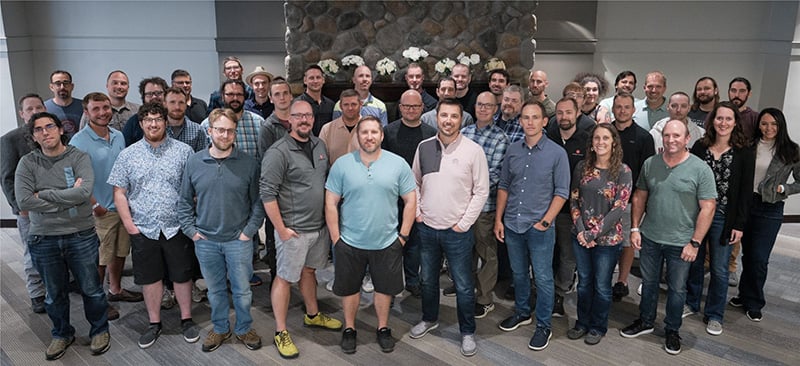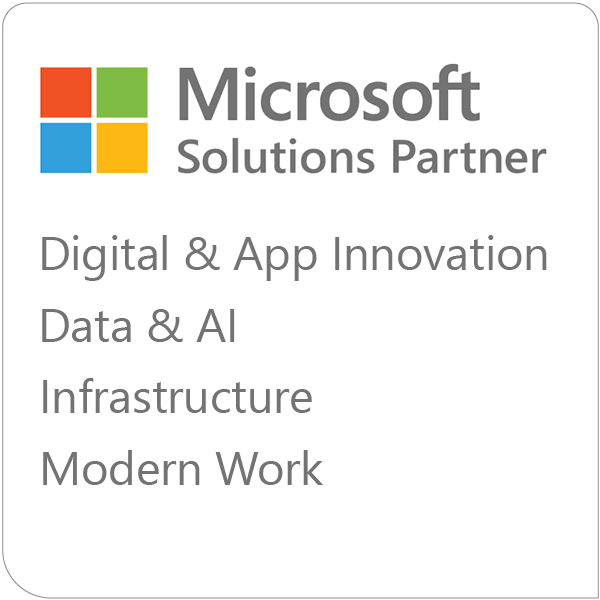By Marc Kermisch, CTO at Emergent Software
In This Blog
- Today’s Cybersecurity Landscape
- What's Changing? The Rise of Malware-Free and AI-Powered Attacks
- The CIO’s Executive Cybersecurity Playbook
- Actionable Tips
- Cybersecurity as a Growth Enabler
- How Emergent Software Can Help
- Final Thoughts
- Frequently Asked Questions
Cybersecurity has moved from a backend IT concern to a boardroom-level priority. There has been a 150% increase in cyberattacks linked to nation-state actors and a 442% spike in social engineering attacks between the first and second half of 2024. The question is no longer if your organization will be targeted, but when.
Here’s a high-level overview of today’s threat landscape:

Cyberattacks are getting more complex and harder to detect.
In 2024, 79% of cyberattacks were malware-free. This means they could easily bypass standard antivirus detection. Just a few years ago, it wasn’t too difficult to spot a phishing email (usually complete with typos and an outrageous from email address). But attackers are now using Generative AI to create more realistic emails, and they’re even going so far as to create fake LinkedIn profiles, texts, and videos to target employees and customers.
Today’s threats are also being driven by “interactive intrusion” tactics. This is where attackers take a more hands-on approach, directly engaging with systems in real time. Instead of deploying automated malware, these threats involve human operators who imitate the behavior of regular users or administrators, which makes their actions much harder to spot.
Here are the top industries that are being targeted:

We all know someone who’s fallen victim to a cyberattack, putting their personal information at risk. Now that work and life are so interconnected, cybercriminals aren't just targeting systems to get at company data anymore; they're going after individual employees. On top of this, attack breakout times are shrinking. It now takes only 48 minutes to put a whole system at risk. That’s why it’s more important now than ever to have an automated, AI-driven response strategy in place to stay proactive.
The threats within the cyber landscape are evolving by the day. Old security techniques aren’t cutting it. That’s why I wanted to provide you with some actionable steps you can take to stay protected. In the playbook below, I outline key priorities and provide you with the tools I trust to build a secure system and protect your organization's assets. I also explain how, when used correctly, cybersecurity can act as an important growth driver.
1. Secure the Entire Identity Ecosystem
35% of cloud security incidents stem from valid account abuse, not malware. This means securing identities at every level is critical and should be a key pillar in your identity and access management strategy. To mitigate risks, you need to secure every layer of your identity infrastructure.
Actionable Tips
Actionable Tips for Strengthening Identity Security:
-
Implement Zero Trust Architecture: Zero Trust assumes no one (inside or outside your organization) is trusted. All users and devices need to verify their identity before gaining access to any system or data.
-
Enforce Multi-Factor Authentication (MFA) and Conditional Access: This will help make sure that even if an employee’s credentials are compromised, unauthorized individuals still won’t be able to access.
-
Leverage AI-Powered Identity Protection: AI solutions can detect abnormal login behaviors in real-time. This makes it easier to spot breaches immediately before they have the chance to escalate.
Technology to Empower Your Efforts: Microsoft Entra ID is an important tool. It provides authentication and Just-in-Time access control, which means only the right people have access to sensitive data.

Source: Microsoft Entra ID
Defend the Cloud as Your Core Infrastructure
This year, cloud-based SaaS exploitation is expected to rise significantly. Protecting your cloud-based environments can’t be an afterthought to your security strategy.
Here’s an example of what that could look like:
Actionable Tips for Defending Cloud Infrastructure:
-
Adopt Cloud-Native Threat Detection: Use security tools designed for cloud environments to detect and respond to threats faster.
-
Monitor and Control SaaS Application Access: You should create access management protocols for cloud apps, making sure that only authorized users can interact with sensitive information.
-
Automate Endpoint and Device Compliance: To be proactive, use continuous monitoring and automatic enforcement of compliance standards to help reduce risk across endpoints and devices.
Technology to Empower Your Efforts: Microsoft Defender XDR uses AI threat intelligence to identify attack patterns quickly, isolate compromised devices in real-time, and prevent further damage to cloud environments.

Source: Microsoft Defender XDR
Eliminate Cross-Domain Visibility Gaps
Many cyberattacks exploit gaps between different security domains, including IT, OT (Operational Technology), and cloud systems. This lack of visibility can make it difficult for security teams to respond to threats in real time.
Actionable Tips for Enhancing Cross-Domain Security:
-
Unify Security Monitoring Across Platforms: Break down silos and integrate security monitoring for cloud, endpoints, and identity systems into a unified platform.
-
Correlate Real-Time Data for Early Threat Detection: Utilize data from all security domains to identify lateral movements within your network, which may indicate a breach in progress.
-
Use Incident-Based Investigations: Rather than reacting to individual alerts, approach threats with a broader investigative mindset that focuses on the root cause of incidents.
Technology to Empower Your Efforts: Microsoft Sentinel, a cloud-native SIEM (Security Information and Event Management) and SOAR (Security Orchestration, Automation, and Response) platform, provides a single-pane-of-glass view of all security threats, making it easier to manage threats across the entire organization.

Source: Microsoft Sentinel
Prioritize Cyber Risk Like a Business Risk
Cybersecurity is a core component of business risk management. With cyber incidents now posing financial and reputational risks akin to operational failures, it’s essential to treat cybersecurity as a business enabler. As you work through your risk assessment framework, don’t just generically identify Cybersecurity as one risk. Break down the key cyber risks pertinent to your business that you must mitigate against.
Actionable Tips for Prioritizing Cyber Risk:
-
Use AI-Powered Threat Intelligence: AI can help predict potential cyberattacks and preemptively block them, reducing the likelihood of a successful breach.
-
Regularly Assess Vulnerabilities: Conduct frequent risk assessments to identify weaknesses in your system and update your defenses accordingly.
-
Treat Cybersecurity as a Business Function: Involve key business leaders in cybersecurity discussions and integrate security considerations into all business strategies.
Technology to Empower Your Efforts: Microsoft Purview provides automated risk assessments and compliance mapping, ensuring your organization adheres to necessary regulations like GDPR, HIPAA, and NIST, while protecting against the evolving cyber threat landscape.

Source: Microsoft Purview
Know Your Adversary and Be Prepared
Cyber threats are changing constantly, becoming more sophisticated and difficult to catch. Nation-state actors, particularly those aligned with China, are increasingly involved in cyberattacks, while AI-driven disinformation campaigns threaten to disrupt markets and even influence elections. To stay ahead, executives must understand the threat landscape and prepare accordingly.
Actionable Tips for Knowing Your Adversary:
-
Train Employees on Social Engineering and Deepfake Awareness: Ensure your team can recognize phishing attempts, social engineering tactics, and deepfake content designed to deceive.
-
Monitor the Dark Web: Stay ahead of emerging threats by actively monitoring underground forums where cybercriminals discuss exploits and breaches.
-
Invest in Proactive Threat Hunting: Use AI and machine learning to search for hidden threats within your network before they can cause harm.
Technology to Empower Your Efforts: Microsoft Defender and Sentinel help drive threat hunting for your organization. Taking advantage of these solutions can help threat hunters streamline hunting procedures by monitoring, detecting, and responding to potential threats.

Source: Microsoft Defender
Prioritizing cybersecurity means taking steps to protect your data, of course. But it also means defending your revenue, reputation, and long-term business success. When your cybersecurity is strong, it can be a powerful growth-driver.
How Cybersecurity Drives Business Growth:
-
Scale Confidently: A robust security framework allows you to expand into new markets without fear of cyber threats.
-
Build Customer Trust: A reputation for strong security can help attract and retain customers.
-
Protect Revenue Streams: Minimizing downtime and securing revenue-critical systems ensures continued financial success.
The organizations that thrive in 2025 will be those that take a proactive approach to cybersecurity, anticipating and preventing threats before they strike. It’s important to be proactive rather than reactive.
Emergent Software is a full-stack technology partner that helps technical leaders build secure, scalable, Microsoft-based solutions.
Whether you’re migrating to Azure, modernizing applications, or enhancing data infrastructure, our teams incorporate security from day one.
Our capabilities include:
-
Secure application development and modernization
-
Azure landing zones and cloud governance
-
SQL Server and Microsoft Fabric data protection
-
Ongoing managed services and 24/7 monitoring
-
Identity management and access controls
From initial kickoff to regular maintenance, we design with security, performance, and long-term maintainability in mind.
Prioritizing cybersecurity in 2025 isn’t an option, it’s a must. Strong security protects your business while enabling trust, scalability, and longevity.
If you’re ready to strengthen your security, Emergent Software is here to help. Start the conversation today.
How is AI used in cybersecurity?
AI plays a major role in strengthening cybersecurity by helping teams detect threats faster and more accurately. It can spot unusual behavior, flag suspicious logins, and even automate responses before damage is done. But it’s a double-edged sword—bad actors are using AI too, to craft more convincing phishing messages, fake identities, and deepfakes. That’s why it’s important to continually train your team and invest in tools that evolve just as fast.
When should we update our response plan?
A good rule of thumb is to review your incident response plan once a year. But don’t stop there. Make sure to revisit it anytime your systems, infrastructure, or team structure change. Running tabletop exercises regularly is a must. They help ensure everyone knows their role and give you a chance to fix any weak spots before a real incident hits. Ideally, tabletop exercises should be run across IT, with business partners, and at the leadership and board level.
What threats are the most common?
Phishing, credential theft, and ransomware remain the top threats organizations face. The twist? Many of these attacks no longer rely on traditional malware, which makes them much harder to detect with legacy security tools. Instead, attackers are using social engineering and AI to outsmart defenses—meaning organizations need to be more proactive than ever.
What are some ways to boost security?
Start with the basics: enable multi-factor authentication (MFA), make sure all devices are protected with antivirus software, and train your employees to spot phishing attempts. Once those are in place, look at tools that offer AI-driven monitoring, identity protection, and automated threat detection. These layers can help you stay one step ahead without overwhelming your team.







